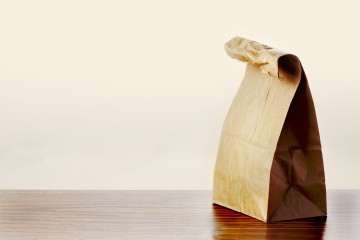
3 Powerful Ways to Eat Less at Restaurants
Do you overeat at restaurants? Let’s be honest; we all do. After all, there are just too many factors gently encouraging us to eat more. Like the size of our plates, the dark ambiance and our increasing portions! Not to mention, we tend to be members of the “clean plate club,” which means if food is put in front of us, we eat almost everything. Many of my clients are surprised to discover that the average restaurant entree contains a whopping 1,200-1,500 calories– and this does not include beverage(s), appetizer(s) or dessert! Similarly, the nutrition is comparable whether you eat at your favourite chain or even non-chain establishments.
However, there is another way. Today, I will be sharing three powerful strategies to help you eat less at restaurants without feeling deprived! I will be highlighting findings from my favourite author and researcher, Brian Wansink from Cornell University. Be sure to check out Wansink’s thought-provoking and action-oriented books, Mindless Eating and Slim by Design.
Three simple ways you can eat less at restaurants:
1. Request your Seat Wisely
Bet you did not realize that where you sit in the restaurant impacts your food intake?Wansink’s research looked into where people sit and the healthfulness of the foods they ordered. His team found that people actually ordered healthier foods if they sat by a window or in a well-lit part of the restaurant. Additionally, those sitting at high top tables ordered more salads and fewer desserts. Conversely, people ordered heavier food (and more of it) when they sat in a dark table or booth. Interestingly, those sitting in spots furthest from the front door ate the fewest salads and were 73 percent more likely to order dessert (Slim by Design, 2014).
People tend to order heavier food (and more of it) when they sat in a dark table or booth Share on XIt was hypothesized by Wansink’s team that the darker the table, the less guilty and self-conscious people felt. On the other hand, when people are seated by windows or by the front door, they are more self-aware and this may have prompted different choices.
Next time the hostess brings you to your table, request a spot that fits Wansink’s “healthier seating” criteria:
- Well-lit area
- Near windows
- Elevated tables
- Far from the bar, kitchen or TV
2. Limit the Freebies
Restaurants want to keep us happy, full and perceiving good value. This is the very reason why they offer “free carbs” like bread or tortillas as an inexpensive way to keep us happy and perceiving extra value.
However, many do not realize how quickly these freebies add up. We also do not realize how strong the “in sight, in stomach” rule applies when bread is placed in front of us. Who wants to say no to that?
To explore how much people are actually consuming, Wansink found that diners served olive oil and bread ate 264 calories worth of bread compared to 319 calories for those served bread and butter (Slim by Design, 2014).
Wansink found that diners served olive oil and bread ate 264 calories worth of bread Share on XWhat to do?
- Request waters when the server greets you; this ensure you are well hydrated. We often mistake a feel of hunger when we are actually thirsty.
- Ask the server to not bring bread over – caution: this might not be feasible if you are dining with others who want bread.
- Dip bread in olive oil instead of butter to consume less bread.
3. Use “To-Go Containers”
This is my favourite strategy. When eating out, shift your mindset from the default of finishing what is served to thinking about what food that you could take home! After all, this will make for an easy meal or a snack for later in the day.
The “to-go box” is the most underutilized tool used by only 18 percent of diners (Slim by Design, 2014). Wansink and his team discovered that the reason behind this (besides not wanting to look cheap) is based on a theory known as the “endowment effect.” This means that we value things more when we feel that we own them. Therefore, before we order food, we don’t own it. But once we order food, psychologically we “own” it. Therefore, it becomes harder to take away from us, even in a “to-go box!”
Only 18 percent of diners asking for boxes (Slim by Design, 2014) Share on XTo help restaurant patrons not feel compelled to eat their entire 1500 calorie Pad Thai in one seating, Wansink experimented to find a better solution. His team found that when waiters tell patrons before they order their food that the portions are large and that there are “to-go boxes” available, this increased the likelihood (by 40%) that diners would take home leftovers. However, if the patrons ordered first (they now owned their food order) and were then notified by the waiter of the to-go containers, this was too late to change the endowment effect and likelihood of taking home leftovers.
What to do?
- Go into restaurants knowing that you will be served double of what you need and tell yourself ahead of time “the portions are large and there are “to-go boxes” available.”
- Request half of the portion to be put in a “to-go box” before being serving to you – this is helpful since it takes away the visual cue to clean your plate.
- Notice how satisfied you feel after eating half as much.
Bottom Line:
Eating out at restaurants is a treat and a time to enjoy friends, family or colleagues. However, restaurants can also be a recipe for overeating and feeling over-stuffed or sluggish. To prevent overeating next time you are out, request your seat wisely, think twice about the freebies and plan your leftovers for tomorrow with a “to-go box.”





